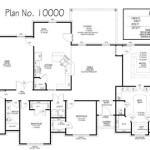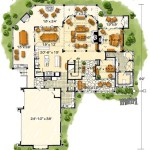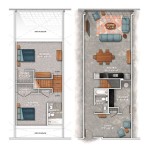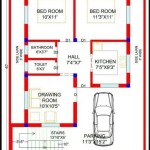Open Concept Colonial Floor Plans: A Modern Interpretation of a Classic Design
Colonial architecture, with its symmetrical facades, prominent columns, and emphasis on formality, has long been a staple of American residential design. Traditionally, colonial homes featured a defined floor plan with distinct rooms serving specific purposes. The shift towards open concept living, emphasizing fluidity and connectivity between spaces, has led to the emergence of open concept colonial floor plans, a hybrid design that seeks to merge the best of both worlds.
This article will explore the intricacies of open concept colonial floor plans, examining how they blend traditional architectural elements with modern design preferences. We will analyze the key features, benefits, and potential challenges of this architectural style, offering insights for prospective homeowners and design professionals alike. The discussion will delve into how the iconic colonial aesthetic can be adapted to accommodate contemporary lifestyles that prioritize spaciousness, natural light, and seamless integration of living areas.
Key Features of Open Concept Colonial Homes
Open concept colonial floor plans represent a significant departure from the compartmentalized layouts typically associated with traditional colonial architecture. While maintaining the exterior characteristics of the colonial style, the interior is redesigned to create a more expansive and interconnected living space. Several defining features characterize this modern interpretation:
1. Blurring the Lines Between Rooms: The most notable feature is the reduction, or complete removal, of walls separating the kitchen, living room, and dining area. This creates a large, continuous space that promotes interaction and facilitates a more casual and communal atmosphere. Instead of distinct, enclosed rooms, these areas flow seamlessly into one another, defined more by changes in flooring, furniture arrangement, or subtle architectural details like columns or half-walls.
2. Enhanced Natural Light: Open floor plans inherently benefit from increased natural light penetration. With fewer interior walls obstructing the flow of light, windows can illuminate a larger area, creating a brighter and more inviting ambiance. Strategically placed windows, skylights, or even a sunroom addition can further enhance the natural light within the open space. This is particularly appealing as traditional colonial homes, with their smaller windows and numerous rooms, could sometimes feel dark and enclosed.
3. Maintaining Colonial Aesthetics: Despite the open interior, the exterior of the house typically retains the classic colonial style. This includes features such as a symmetrical façade, centered front door, evenly spaced windows, and often includes details like columns, shutters, and a gabled roof. The goal is to preserve the historical charm of the colonial style while adapting the interior to suit modern living preferences. This blend of old and new creates a visually appealing and functional living environment.
4. Centralized Gathering Spaces: Open concept colonial homes emphasize the creation of a central gathering space where family members can interact and spend time together. This often involves a large living area connected to an open kitchen with an island or breakfast bar, providing a natural hub for social interaction. This centralized design encourages a sense of togetherness and facilitates easier communication within the household.
5. Preservation of Formal Elements: While the primary living areas are open, elements of the traditional colonial design can still be incorporated. A formal dining room, a study, or a library might be retained as separate, more defined spaces. This allows for the preservation of formal entertaining areas while still enjoying the benefits of an open and casual living space in the primary area of the home.
6. Improved Flow and Functionality: The open layout often provides a better flow between different areas of the home, making it easier to move around and perform daily tasks. This is particularly beneficial for families with young children, as parents can easily supervise activities in different areas of the house. The enhanced functionality can also be appealing to those who enjoy entertaining, as the open space allows for easier mingling and serving of guests.
Benefits of Open Concept Colonial Designs
The popularity of open concept colonial floor plans stems from the numerous benefits they offer in terms of functionality, aesthetics, and lifestyle. These benefits contribute to a more comfortable and enjoyable living experience:
1. Enhanced Social Interaction: One of the primary advantages is the promotion of social interaction within the household. The open space encourages family members to spend more time together, fostering a sense of connection and communication. This is especially important in today's fast-paced world, where families may have limited opportunities for quality time together. The open layout provides a natural setting for conversations, shared activities, and casual gatherings.
2. Increased Natural Light and Ventilation: The absence of interior walls allows for more natural light to penetrate deeper into the house, creating a brighter and more cheerful living environment. This can have a positive impact on mood and productivity. Additionally, open layouts often facilitate better ventilation, allowing for more airflow and reducing the reliance on artificial cooling systems. This can lead to energy savings and a healthier indoor environment.
3. Improved Functionality and Flexibility: Open concept designs offer greater flexibility in terms of furniture arrangement and space utilization. The large, open space can be easily adapted to accommodate different needs and lifestyles. For example, the living area can be reconfigured to create a home office, a play area, or a workout space. The flexibility of the open layout allows homeowners to customize the space to suit their specific requirements.
4. Enhanced Entertaining Capabilities: Open concept layouts are ideal for entertaining guests. The seamless flow between the kitchen, living room, and dining area makes it easier to mingle and serve refreshments. The open space also provides ample room for guests to move around comfortably. The kitchen, often the focal point of an open concept design, can be designed to be both functional and aesthetically pleasing, serving as a gathering place for guests and a hub for culinary activities.
5. Modernized Colonial Aesthetic: Open concept colonial homes offer a unique blend of traditional charm and modern design. The exterior retains the classic colonial aesthetic, while the interior is updated to reflect contemporary living preferences. This combination of old and new creates a visually appealing and functional living environment that appeals to a wide range of homeowners. It allows for enjoying the timeless elegance of the colonial style without sacrificing the convenience and comfort of modern living.
6. Increased Property Value: In many markets, open concept homes tend to be more desirable and command higher prices than traditional, compartmentalized homes. The open layout is often seen as a desirable feature by potential buyers, reflecting the current trend towards more casual and interactive living spaces. This can make open concept colonial homes a sound investment, providing a good return on investment upon resale.
Potential Challenges and Considerations
While open concept colonial floor plans offer numerous advantages, it is important to consider the potential challenges and drawbacks before embarking on this architectural approach. Careful planning and design are essential to ensure that the open layout is functional, comfortable, and aesthetically pleasing:
1. Noise Control: One of the primary challenges is noise control. In an open space, sound can travel easily, making it difficult to create quiet areas for relaxation or concentration. This is particularly important for families with young children or those who work from home. To mitigate this issue, it is important to consider the acoustics of the space and incorporate sound-absorbing materials, such as rugs, curtains, and upholstered furniture.
2. Lack of Privacy: The open layout can also compromise privacy within the household. It may be difficult to find a quiet space for individual activities or conversations. This is especially important to consider when designing homes for multiple occupants with varying needs and schedules. Incorporating designated quiet zones, such as a study or a library, can help to address this issue. Using screens, partitions, or furniture arrangements to create visual barriers can also enhance privacy within the open space.
3. Temperature Regulation: Heating and cooling an open space can be more challenging than regulating the temperature in smaller, enclosed rooms. The large, open area may require a more powerful HVAC system to ensure consistent temperature throughout the space. It is also important to consider the placement of windows and doors to minimize heat loss or gain. Utilizing energy-efficient windows and insulation can help to reduce energy consumption and maintain a comfortable temperature.
4. Design Cohesion: Maintaining design cohesion in an open space can be challenging. It is important to ensure that the different areas within the open layout complement each other and create a unified aesthetic. This requires careful consideration of color palettes, furniture styles, and architectural details. A cohesive design can help to create a harmonious and visually appealing living environment. It is also important to define distinct zones within the open space using rugs, furniture arrangements, or changes in flooring. This can help to create a sense of order and organization.
5. Visual Clutter: Open concept layouts can be prone to visual clutter if not properly organized and maintained. The absence of walls can make it easier for clutter to accumulate, creating a disorganized and visually distracting environment. Implementing effective storage solutions, such as built-in cabinets, shelving units, and storage ottomans, can help to minimize clutter and maintain a clean and organized living space. Regularly decluttering and organizing the space is also essential to maintain a visually appealing environment.
6. Cost Considerations: Removing walls and reconfiguring the layout of a traditional colonial home can be a significant undertaking, potentially incurring higher renovation costs. Structural modifications, such as removing load-bearing walls, may require the expertise of a structural engineer and the installation of supportive beams. It is important to factor in these costs when budgeting for an open concept renovation. Furthermore, selecting higher-quality materials and finishes can also increase the overall cost of the project.

Renovation Ideas Playing With A Colonial S Floor Plan

Pin By Dena Blomquist On House Plans Colonial Floor Basement

Plan 027h 0340 The House

Renovation Ideas Playing With A Colonial S Floor Plan

4 Bedroom Floor Plans Monmouth County Ocean New Jersey Rba Homes

House Plan 3 Bedrooms 2 Bathrooms 4756 Drummond Plans

Pin By Sl On Cocina Floor Plans House Center Hall Colonial Plan

2 Story Colonial Floor Plans Monmouth County Ocean New Jersey Rba Homes

Your Open Concept Floor Plan Here S How To Fix It Laurel Home

House Plan 61301 Quality Plans From Ahmann Design








